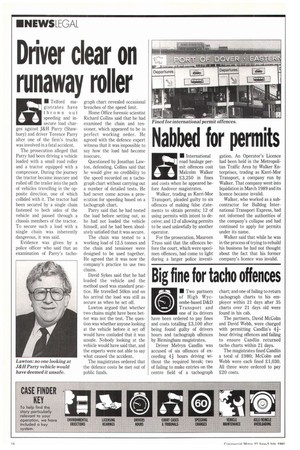Driver clear on runaway roller
Page 18

If you've noticed an error in this article please click here to report it so we can fix it.
6 6
• Telford magistrates have thrown out speeding and insecure load charges against J&H Parry (Shawbury) and driver Terence Parry after one of the firm's trucks was involved in a fatal accident.
The prosecution alleged that Parry had been driving a vehicle loaded with a small road roller and a tractor equipped with a compressor. During the journey the tractor became insecure and rolled off the trailer into the path of vehicles travelling in the opposite direction, one of which collided with it. The tractor had been secured by a single chain fastened to both sides of the vehicle and passed through a chassis members of the tractor. To secure such a load with a single chain was inherently dangerous, it was said.
Evidence was given by a police officer who said that an examination of Parry's tacho graph chart revealed occasional breaches of the speed limit.
Home Office forensic scientist Richard Collins said that he had examined the chain and tensioner, which appeared to be in perfect working order. He agreed with the defence expert witness that it was impossible to say how the load had become insecure.
Questioned by Jonathan Lawton, defending, Collins said that he would give no credibility to the speed recorded on a tachograph chart without carrying out a number of detailed tests. He had never come across a prosecution for speeding based on a tachograph chart.
Parry said that he had tested the load before setting out, as he had not loaded the vehicle himself, and he had been absolutely satisfied that it was secure.
The chain was tested to a working load of 12.5 tonnes and the chain and tensioner were designed to be used together. He agreed that it was now the company's practice to use two chains.
David Sykes said that he had loaded the vehicle and the method used was standard practice. He travelled 50km and on his arrival the load was still as secure as when he set off.
Lawton argued that whether two chains might have been better was not the test. The question was whether anyone looking at the vehicle before it set off would have conluded that it was unsafe. Nobody looking at the vehicle would have said that, and the experts were not able to say what caused the accident.
The magistrates ordered that the defence costs be met out of public funds.












































































































